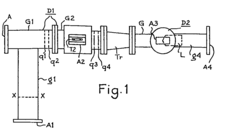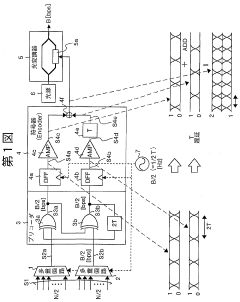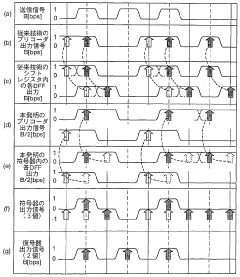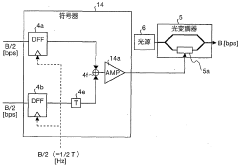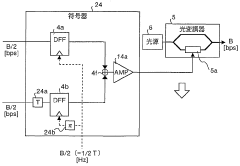World-Class Multiplexer Innovations in Robotics
JUL 13, 20259 MIN READ
Generate Your Research Report Instantly with AI Agent
Patsnap Eureka helps you evaluate technical feasibility & market potential.
Robotics Multiplexer Evolution and Objectives
Robotics multiplexers have undergone significant evolution since their inception, driven by the increasing complexity and demands of modern robotic systems. Initially, multiplexers in robotics were simple devices used to combine multiple input signals into a single output channel. However, as robots became more sophisticated, the need for advanced multiplexing technologies grew exponentially.
The evolution of robotics multiplexers can be traced through several key stages. In the early days of robotics, analog multiplexers were predominant, allowing for basic signal routing and sensor data management. As digital technologies advanced, digital multiplexers emerged, offering improved precision and reliability in signal processing. The advent of programmable logic devices further revolutionized multiplexer design, enabling more flexible and customizable solutions for robotic applications.
Recent years have seen a shift towards intelligent multiplexing systems, incorporating microprocessors and advanced algorithms to optimize signal routing and processing in real-time. These smart multiplexers can adapt to changing conditions and prioritize critical data streams, enhancing the overall performance and responsiveness of robotic systems.
The objectives of world-class multiplexer innovations in robotics are multifaceted and ambitious. One primary goal is to increase the bandwidth and speed of data transmission within robotic systems. This is crucial for enabling more complex and data-intensive applications, such as real-time image processing and advanced sensor fusion.
Another key objective is to reduce latency and improve the synchronization of multiple data streams. In robotics, precise timing and coordination of various subsystems are essential for smooth operation and accurate control. Innovative multiplexer designs aim to minimize delays and ensure that all components of a robotic system operate in harmony.
Miniaturization and power efficiency are also critical objectives in multiplexer development. As robots become more compact and mobile, there is a growing need for smaller, lighter, and more energy-efficient multiplexing solutions. This drives research into novel materials and circuit designs that can deliver high performance in a reduced form factor.
Furthermore, enhancing the reliability and robustness of multiplexers is a constant focus. Robotics often operate in challenging environments, necessitating multiplexers that can withstand electromagnetic interference, temperature variations, and physical stress. Innovations in this area include advanced shielding techniques, self-diagnostic capabilities, and fault-tolerant architectures.
Looking ahead, the future objectives of multiplexer innovations in robotics include integration with artificial intelligence and machine learning algorithms. This convergence aims to create adaptive multiplexing systems that can optimize data flow based on learned patterns and predictive analytics, further enhancing the autonomy and intelligence of robotic systems.
The evolution of robotics multiplexers can be traced through several key stages. In the early days of robotics, analog multiplexers were predominant, allowing for basic signal routing and sensor data management. As digital technologies advanced, digital multiplexers emerged, offering improved precision and reliability in signal processing. The advent of programmable logic devices further revolutionized multiplexer design, enabling more flexible and customizable solutions for robotic applications.
Recent years have seen a shift towards intelligent multiplexing systems, incorporating microprocessors and advanced algorithms to optimize signal routing and processing in real-time. These smart multiplexers can adapt to changing conditions and prioritize critical data streams, enhancing the overall performance and responsiveness of robotic systems.
The objectives of world-class multiplexer innovations in robotics are multifaceted and ambitious. One primary goal is to increase the bandwidth and speed of data transmission within robotic systems. This is crucial for enabling more complex and data-intensive applications, such as real-time image processing and advanced sensor fusion.
Another key objective is to reduce latency and improve the synchronization of multiple data streams. In robotics, precise timing and coordination of various subsystems are essential for smooth operation and accurate control. Innovative multiplexer designs aim to minimize delays and ensure that all components of a robotic system operate in harmony.
Miniaturization and power efficiency are also critical objectives in multiplexer development. As robots become more compact and mobile, there is a growing need for smaller, lighter, and more energy-efficient multiplexing solutions. This drives research into novel materials and circuit designs that can deliver high performance in a reduced form factor.
Furthermore, enhancing the reliability and robustness of multiplexers is a constant focus. Robotics often operate in challenging environments, necessitating multiplexers that can withstand electromagnetic interference, temperature variations, and physical stress. Innovations in this area include advanced shielding techniques, self-diagnostic capabilities, and fault-tolerant architectures.
Looking ahead, the future objectives of multiplexer innovations in robotics include integration with artificial intelligence and machine learning algorithms. This convergence aims to create adaptive multiplexing systems that can optimize data flow based on learned patterns and predictive analytics, further enhancing the autonomy and intelligence of robotic systems.
Market Demand for Advanced Robotic Control Systems
The demand for advanced robotic control systems has been experiencing significant growth, driven by the increasing adoption of robotics across various industries. This surge in demand is particularly evident in manufacturing, healthcare, logistics, and agriculture sectors, where the need for precise and efficient robotic operations is paramount.
In the manufacturing industry, there is a growing requirement for robotic systems capable of handling complex tasks with high precision and flexibility. Companies are seeking control systems that can seamlessly integrate with existing production lines while offering enhanced adaptability to changing production requirements. This demand is further fueled by the push towards Industry 4.0 and smart manufacturing initiatives.
The healthcare sector presents a unique market opportunity for advanced robotic control systems. Surgical robots, rehabilitation devices, and assistive technologies all require sophisticated control mechanisms to ensure patient safety and treatment efficacy. The aging population in many developed countries is also contributing to the increased demand for robotic systems in elderly care and medical assistance.
In logistics and warehousing, the e-commerce boom has created a substantial market for robotic solutions. Companies are investing in automated guided vehicles (AGVs) and robotic picking systems to improve efficiency and reduce operational costs. These applications require robust control systems capable of real-time decision-making and seamless integration with warehouse management systems.
The agriculture sector is another area witnessing a rising demand for advanced robotic control systems. Precision agriculture techniques, autonomous tractors, and robotic harvesting systems are gaining traction as farmers seek to optimize crop yields and reduce labor costs. These applications require control systems that can operate reliably in challenging outdoor environments and integrate with various sensors and GPS technologies.
The market for advanced robotic control systems is also being shaped by emerging technologies such as artificial intelligence and machine learning. There is a growing demand for control systems that can leverage these technologies to enable adaptive and self-learning capabilities in robots, allowing them to perform more complex tasks and operate in dynamic environments.
Geographically, the demand is particularly strong in regions with high labor costs and a strong focus on technological innovation, such as North America, Europe, and parts of Asia. However, developing economies are also showing increased interest in robotic solutions as they seek to modernize their industries and improve productivity.
As the robotics industry continues to evolve, the market demand for advanced control systems is expected to grow further. Key factors driving this growth include the need for increased automation, the push for higher productivity and efficiency, and the expanding range of applications for robotic technologies across various sectors.
In the manufacturing industry, there is a growing requirement for robotic systems capable of handling complex tasks with high precision and flexibility. Companies are seeking control systems that can seamlessly integrate with existing production lines while offering enhanced adaptability to changing production requirements. This demand is further fueled by the push towards Industry 4.0 and smart manufacturing initiatives.
The healthcare sector presents a unique market opportunity for advanced robotic control systems. Surgical robots, rehabilitation devices, and assistive technologies all require sophisticated control mechanisms to ensure patient safety and treatment efficacy. The aging population in many developed countries is also contributing to the increased demand for robotic systems in elderly care and medical assistance.
In logistics and warehousing, the e-commerce boom has created a substantial market for robotic solutions. Companies are investing in automated guided vehicles (AGVs) and robotic picking systems to improve efficiency and reduce operational costs. These applications require robust control systems capable of real-time decision-making and seamless integration with warehouse management systems.
The agriculture sector is another area witnessing a rising demand for advanced robotic control systems. Precision agriculture techniques, autonomous tractors, and robotic harvesting systems are gaining traction as farmers seek to optimize crop yields and reduce labor costs. These applications require control systems that can operate reliably in challenging outdoor environments and integrate with various sensors and GPS technologies.
The market for advanced robotic control systems is also being shaped by emerging technologies such as artificial intelligence and machine learning. There is a growing demand for control systems that can leverage these technologies to enable adaptive and self-learning capabilities in robots, allowing them to perform more complex tasks and operate in dynamic environments.
Geographically, the demand is particularly strong in regions with high labor costs and a strong focus on technological innovation, such as North America, Europe, and parts of Asia. However, developing economies are also showing increased interest in robotic solutions as they seek to modernize their industries and improve productivity.
As the robotics industry continues to evolve, the market demand for advanced control systems is expected to grow further. Key factors driving this growth include the need for increased automation, the push for higher productivity and efficiency, and the expanding range of applications for robotic technologies across various sectors.
Current Multiplexer Technologies in Robotics
Multiplexers play a crucial role in modern robotics, enabling efficient data transmission and control in complex robotic systems. Current multiplexer technologies in robotics focus on enhancing data throughput, reducing latency, and improving overall system performance.
One of the primary multiplexer technologies employed in robotics is time-division multiplexing (TDM). TDM allows multiple data streams to share a single communication channel by allocating time slots to each stream. This approach is particularly useful in robotic applications where numerous sensors and actuators need to communicate with a central processing unit. Advanced TDM implementations in robotics utilize adaptive time slot allocation algorithms to optimize data transmission based on real-time requirements.
Frequency-division multiplexing (FDM) is another technology gaining traction in robotics. FDM assigns different frequency bands to various data streams, enabling simultaneous transmission over a single channel. This technique is especially beneficial in robotic systems that require continuous monitoring of multiple sensors, such as in autonomous vehicles or industrial robots operating in complex environments.
Wavelength-division multiplexing (WDM) has emerged as a promising technology for high-bandwidth robotic applications. WDM leverages different wavelengths of light to transmit multiple data streams over optical fibers. This approach allows for extremely high data rates and is particularly useful in robotic systems that process large amounts of visual or sensor data, such as in advanced machine vision applications.
Code-division multiplexing (CDM) is gaining popularity in robotics due to its robustness against interference and ability to support multiple simultaneous transmissions. CDM assigns unique codes to different data streams, allowing them to be transmitted simultaneously and separated at the receiver. This technology is particularly valuable in robotic swarms or multi-robot systems where numerous units need to communicate simultaneously without interference.
Statistical multiplexing has found applications in robotic systems with variable data rates. This technique dynamically allocates bandwidth based on the current needs of different data streams, optimizing overall system performance. Statistical multiplexing is particularly useful in robotic applications with fluctuating sensor data rates or varying control requirements.
Recent advancements in multiplexer technologies for robotics include the development of hybrid multiplexing schemes that combine multiple techniques to achieve optimal performance. For instance, some robotic systems employ a combination of TDM and FDM to maximize data throughput while maintaining flexibility in resource allocation.
Furthermore, software-defined networking (SDN) principles are being applied to multiplexing in robotics, allowing for dynamic reconfiguration of data paths and multiplexing schemes based on changing system requirements. This approach enhances adaptability and efficiency in complex robotic systems, particularly in industrial automation and autonomous vehicle applications.
One of the primary multiplexer technologies employed in robotics is time-division multiplexing (TDM). TDM allows multiple data streams to share a single communication channel by allocating time slots to each stream. This approach is particularly useful in robotic applications where numerous sensors and actuators need to communicate with a central processing unit. Advanced TDM implementations in robotics utilize adaptive time slot allocation algorithms to optimize data transmission based on real-time requirements.
Frequency-division multiplexing (FDM) is another technology gaining traction in robotics. FDM assigns different frequency bands to various data streams, enabling simultaneous transmission over a single channel. This technique is especially beneficial in robotic systems that require continuous monitoring of multiple sensors, such as in autonomous vehicles or industrial robots operating in complex environments.
Wavelength-division multiplexing (WDM) has emerged as a promising technology for high-bandwidth robotic applications. WDM leverages different wavelengths of light to transmit multiple data streams over optical fibers. This approach allows for extremely high data rates and is particularly useful in robotic systems that process large amounts of visual or sensor data, such as in advanced machine vision applications.
Code-division multiplexing (CDM) is gaining popularity in robotics due to its robustness against interference and ability to support multiple simultaneous transmissions. CDM assigns unique codes to different data streams, allowing them to be transmitted simultaneously and separated at the receiver. This technology is particularly valuable in robotic swarms or multi-robot systems where numerous units need to communicate simultaneously without interference.
Statistical multiplexing has found applications in robotic systems with variable data rates. This technique dynamically allocates bandwidth based on the current needs of different data streams, optimizing overall system performance. Statistical multiplexing is particularly useful in robotic applications with fluctuating sensor data rates or varying control requirements.
Recent advancements in multiplexer technologies for robotics include the development of hybrid multiplexing schemes that combine multiple techniques to achieve optimal performance. For instance, some robotic systems employ a combination of TDM and FDM to maximize data throughput while maintaining flexibility in resource allocation.
Furthermore, software-defined networking (SDN) principles are being applied to multiplexing in robotics, allowing for dynamic reconfiguration of data paths and multiplexing schemes based on changing system requirements. This approach enhances adaptability and efficiency in complex robotic systems, particularly in industrial automation and autonomous vehicle applications.
State-of-the-Art Multiplexer Solutions for Robots
01 Optical multiplexing systems
Optical multiplexers are used in fiber optic communication systems to combine multiple optical signals onto a single fiber. These systems often employ wavelength division multiplexing (WDM) to increase data transmission capacity. Advanced optical multiplexers may incorporate tunable lasers, optical switches, and signal processing techniques to optimize performance and flexibility.- Optical multiplexing systems: Optical multiplexers are used in fiber optic communication systems to combine multiple optical signals into a single fiber. These systems often employ wavelength division multiplexing (WDM) to increase data transmission capacity. Advanced optical multiplexers may incorporate tunable lasers, optical switches, and signal processing techniques to optimize performance and flexibility.
- Digital multiplexing techniques: Digital multiplexers are essential components in digital communication systems, allowing multiple data streams to be combined into a single transmission channel. These devices employ various techniques such as time-division multiplexing (TDM) and frequency-division multiplexing (FDM) to efficiently utilize bandwidth. Advanced digital multiplexers may incorporate error correction, compression, and adaptive modulation schemes to enhance reliability and throughput.
- Multiplexer circuit design: The design of multiplexer circuits involves careful consideration of factors such as power consumption, switching speed, and signal integrity. Advanced multiplexer designs may incorporate techniques such as pass transistor logic, transmission gates, or dynamic logic to optimize performance. Some designs focus on reducing propagation delay and minimizing crosstalk between channels.
- Multiplexers in display technology: Multiplexers play a crucial role in display technologies, particularly in addressing and driving individual pixels in large-scale displays. These multiplexers are designed to handle high-frequency signals and maintain signal integrity across the display panel. Advanced designs may incorporate features such as charge sharing and voltage boosting to improve efficiency and image quality.
- Reconfigurable and programmable multiplexers: Reconfigurable and programmable multiplexers offer increased flexibility in system design by allowing dynamic changes to their configuration. These devices may incorporate field-programmable gate arrays (FPGAs) or other programmable logic to adapt to changing requirements. Some designs focus on reducing the complexity of control circuitry while maintaining high performance and reliability.
02 Digital multiplexers for data communication
Digital multiplexers are crucial components in data communication networks, allowing multiple data streams to be combined and transmitted over a single channel. These devices often incorporate advanced signal processing algorithms, error correction techniques, and synchronization mechanisms to ensure reliable data transmission. They may also support various communication protocols and interfaces to accommodate different network architectures.Expand Specific Solutions03 Multiplexers in wireless communication systems
Multiplexers play a vital role in wireless communication systems, enabling efficient use of radio frequency spectrum. These devices are used in base stations, mobile devices, and other wireless equipment to combine multiple input signals for transmission or separate received signals. Advanced multiplexer designs may incorporate adaptive algorithms, beamforming techniques, and software-defined radio concepts to enhance performance and flexibility.Expand Specific Solutions04 Multiplexers for sensor and imaging applications
Multiplexers are essential in various sensor and imaging systems, allowing multiple sensor inputs to be combined and processed efficiently. These devices are used in applications such as medical imaging, environmental monitoring, and industrial automation. Advanced multiplexer designs may incorporate on-chip signal conditioning, analog-to-digital conversion, and intelligent power management to optimize system performance and reduce overall complexity.Expand Specific Solutions05 High-speed multiplexers for data processing
High-speed multiplexers are critical components in data processing systems, enabling rapid switching and routing of digital signals. These devices are used in applications such as high-performance computing, network routers, and test and measurement equipment. Advanced multiplexer designs may incorporate novel semiconductor materials, advanced packaging techniques, and innovative circuit topologies to achieve higher operating frequencies and lower power consumption.Expand Specific Solutions
Key Players in Robotic Multiplexer Industry
The competitive landscape for "World-Class Multiplexer Innovations in Robotics" is characterized by a mature market with significant growth potential. The industry is in a phase of rapid technological advancement, driven by increasing demand for sophisticated robotics solutions across various sectors. Key players like Qualcomm, ABB Group, and Mitsubishi Electric are leading the charge with their advanced multiplexer technologies. The market size is substantial, with projections indicating continued expansion due to the rising adoption of robotics in manufacturing, healthcare, and consumer applications. Technological maturity varies, with established companies like Altera Corp. (now part of Intel) offering proven solutions, while emerging players like MUJIN, Inc. are introducing innovative approaches to multiplexer design in robotics.
ABB Group
Technical Solution: ABB Group has developed innovative multiplexing solutions for industrial robotics applications. Their YuMi collaborative robot utilizes advanced multiplexing techniques to coordinate its dual-arm operations, allowing for complex, synchronized movements[5]. ABB's multiplexing innovations extend to their RobotStudio software, which uses virtual multiplexing to simulate and program multiple robots simultaneously, significantly reducing setup times in industrial settings[6]. Additionally, ABB has implemented fieldbus multiplexing in their robot controllers, allowing for efficient communication between robots and various sensors and actuators in industrial automation systems[7].
Strengths: Robust and reliable multiplexing for industrial applications, seamless integration with existing automation systems. Weaknesses: May be less flexible for non-industrial applications, potentially higher costs for small-scale implementations.
QUALCOMM, Inc.
Technical Solution: Qualcomm has made significant contributions to multiplexer innovations in robotics through their advanced mobile platforms and AI technologies. Their Robotics RB5 platform utilizes sophisticated multiplexing techniques to integrate multiple sensors, cameras, and AI processors for autonomous robot navigation and control[10]. Qualcomm's multiplexing innovations leverage their expertise in 5G and edge computing, allowing for efficient processing and transmission of large amounts of sensor data in real-time. They have also developed advanced power management multiplexing techniques, optimizing energy consumption across various robotic subsystems[11].
Strengths: Excellent integration of AI, 5G, and edge computing for robotics applications, energy-efficient designs. Weaknesses: Primarily focused on mobile and consumer robotics, may have limitations in heavy industrial applications.
Breakthrough Multiplexer Patents in Robotics
Multiplexing device for combining two frequency bands
PatentInactiveEP0098192A1
Innovation
- A simplified multiplexing device design featuring a first duplexer with a common guide and a second polarization duplexer, utilizing single coupling holes with tuned resonators and quasi-optical filters to separate orthogonal polarizations, reducing mechanical complexity and costs while maintaining performance.
Multiplexer
PatentWO2002078279A1
Innovation
- A multiplexer that time-division multiplexes digital signals, converts them into ternary electric signals, and modulates them into optical signals using a Mach-Zehnder optical modulator, employing flip-flop circuits operating at half the transmission speed and amplification means with saturation characteristics to maintain signal levels, allowing for lower-speed electronic device operation while achieving high-speed optical transmission.
Standardization Efforts in Robotic Multiplexers
In the rapidly evolving field of robotics, standardization efforts for multiplexers have become increasingly crucial. These efforts aim to establish common protocols, interfaces, and performance metrics for robotic multiplexers, facilitating interoperability and accelerating innovation across the industry.
Several international organizations are spearheading these standardization initiatives. The International Organization for Standardization (ISO) has formed a dedicated working group focused on robotic multiplexer standards. This group is developing guidelines for signal transmission, data formats, and connector specifications to ensure seamless integration of multiplexers from different manufacturers.
Concurrently, the Institute of Electrical and Electronics Engineers (IEEE) is working on a comprehensive standard for robotic communication systems, which includes specific provisions for multiplexer technologies. This standard addresses issues such as latency, bandwidth allocation, and error correction mechanisms, providing a robust framework for multiplexer design and implementation.
Industry consortia are also playing a significant role in these standardization efforts. The Robotic Industries Association (RIA) has launched a multiplexer standardization initiative, bringing together leading robotics companies to develop consensus-based standards. This collaborative approach ensures that the resulting standards reflect the practical needs of the industry and are widely adopted.
One of the key challenges in standardization is balancing the need for uniformity with the desire for innovation. To address this, many standardization efforts are adopting a modular approach, defining core requirements while allowing flexibility for advanced features. This strategy enables manufacturers to differentiate their products while maintaining basic compatibility.
Efforts are also underway to harmonize regional standards. The European Committee for Standardization (CEN) and the American National Standards Institute (ANSI) are working together to align their respective multiplexer standards, reducing barriers to global trade and fostering international collaboration in robotics research and development.
As these standardization efforts progress, they are expected to drive significant advancements in robotic multiplexer technology. By establishing common benchmarks and interfaces, these standards will facilitate more rapid development cycles, reduce integration costs, and ultimately accelerate the adoption of advanced robotics across various industries.
Several international organizations are spearheading these standardization initiatives. The International Organization for Standardization (ISO) has formed a dedicated working group focused on robotic multiplexer standards. This group is developing guidelines for signal transmission, data formats, and connector specifications to ensure seamless integration of multiplexers from different manufacturers.
Concurrently, the Institute of Electrical and Electronics Engineers (IEEE) is working on a comprehensive standard for robotic communication systems, which includes specific provisions for multiplexer technologies. This standard addresses issues such as latency, bandwidth allocation, and error correction mechanisms, providing a robust framework for multiplexer design and implementation.
Industry consortia are also playing a significant role in these standardization efforts. The Robotic Industries Association (RIA) has launched a multiplexer standardization initiative, bringing together leading robotics companies to develop consensus-based standards. This collaborative approach ensures that the resulting standards reflect the practical needs of the industry and are widely adopted.
One of the key challenges in standardization is balancing the need for uniformity with the desire for innovation. To address this, many standardization efforts are adopting a modular approach, defining core requirements while allowing flexibility for advanced features. This strategy enables manufacturers to differentiate their products while maintaining basic compatibility.
Efforts are also underway to harmonize regional standards. The European Committee for Standardization (CEN) and the American National Standards Institute (ANSI) are working together to align their respective multiplexer standards, reducing barriers to global trade and fostering international collaboration in robotics research and development.
As these standardization efforts progress, they are expected to drive significant advancements in robotic multiplexer technology. By establishing common benchmarks and interfaces, these standards will facilitate more rapid development cycles, reduce integration costs, and ultimately accelerate the adoption of advanced robotics across various industries.
Energy Efficiency in Robotic Multiplexer Systems
Energy efficiency has become a critical concern in robotic multiplexer systems, driving innovations that aim to optimize power consumption without compromising performance. The focus on energy-efficient designs stems from the increasing demand for autonomous and long-duration robotic operations, particularly in applications such as space exploration, underwater missions, and industrial automation.
One of the primary approaches to enhancing energy efficiency in robotic multiplexer systems involves the development of low-power electronic components. Advanced semiconductor technologies, such as FinFET and FD-SOI, have enabled the creation of multiplexer chips with significantly reduced power consumption. These chips utilize dynamic voltage and frequency scaling techniques to adjust power usage based on the system's workload, ensuring optimal energy utilization.
Another key innovation in this field is the implementation of intelligent power management algorithms. These algorithms leverage machine learning and predictive analytics to anticipate system requirements and dynamically allocate power resources. By analyzing usage patterns and environmental factors, these systems can proactively adjust power distribution, minimizing waste and extending operational lifetimes.
The integration of energy harvesting technologies has also played a crucial role in improving the energy efficiency of robotic multiplexer systems. Techniques such as piezoelectric energy harvesting from mechanical vibrations and photovoltaic cells for solar energy conversion have been successfully incorporated into robotic designs. These innovations allow robots to supplement their power supplies during operation, reducing reliance on external charging and extending mission durations.
Advancements in thermal management have further contributed to energy efficiency improvements. Novel heat dissipation techniques, including phase-change materials and microfluidic cooling systems, have been developed to address the thermal challenges associated with high-performance multiplexer operations. By maintaining optimal operating temperatures, these solutions prevent energy waste due to thermal throttling and extend the lifespan of electronic components.
The adoption of energy-aware communication protocols has also significantly impacted the efficiency of robotic multiplexer systems. These protocols optimize data transmission by minimizing unnecessary communications and implementing adaptive modulation schemes. By reducing the energy overhead associated with data exchange, robots can allocate more power to critical tasks and sensor operations.
As research in this field progresses, emerging technologies such as neuromorphic computing and quantum multiplexing hold promise for revolutionary advancements in energy efficiency. These cutting-edge approaches aim to fundamentally redesign signal processing and data handling in robotic systems, potentially offering orders of magnitude improvements in energy consumption while enhancing overall system capabilities.
One of the primary approaches to enhancing energy efficiency in robotic multiplexer systems involves the development of low-power electronic components. Advanced semiconductor technologies, such as FinFET and FD-SOI, have enabled the creation of multiplexer chips with significantly reduced power consumption. These chips utilize dynamic voltage and frequency scaling techniques to adjust power usage based on the system's workload, ensuring optimal energy utilization.
Another key innovation in this field is the implementation of intelligent power management algorithms. These algorithms leverage machine learning and predictive analytics to anticipate system requirements and dynamically allocate power resources. By analyzing usage patterns and environmental factors, these systems can proactively adjust power distribution, minimizing waste and extending operational lifetimes.
The integration of energy harvesting technologies has also played a crucial role in improving the energy efficiency of robotic multiplexer systems. Techniques such as piezoelectric energy harvesting from mechanical vibrations and photovoltaic cells for solar energy conversion have been successfully incorporated into robotic designs. These innovations allow robots to supplement their power supplies during operation, reducing reliance on external charging and extending mission durations.
Advancements in thermal management have further contributed to energy efficiency improvements. Novel heat dissipation techniques, including phase-change materials and microfluidic cooling systems, have been developed to address the thermal challenges associated with high-performance multiplexer operations. By maintaining optimal operating temperatures, these solutions prevent energy waste due to thermal throttling and extend the lifespan of electronic components.
The adoption of energy-aware communication protocols has also significantly impacted the efficiency of robotic multiplexer systems. These protocols optimize data transmission by minimizing unnecessary communications and implementing adaptive modulation schemes. By reducing the energy overhead associated with data exchange, robots can allocate more power to critical tasks and sensor operations.
As research in this field progresses, emerging technologies such as neuromorphic computing and quantum multiplexing hold promise for revolutionary advancements in energy efficiency. These cutting-edge approaches aim to fundamentally redesign signal processing and data handling in robotic systems, potentially offering orders of magnitude improvements in energy consumption while enhancing overall system capabilities.
Unlock deeper insights with Patsnap Eureka Quick Research — get a full tech report to explore trends and direct your research. Try now!
Generate Your Research Report Instantly with AI Agent
Supercharge your innovation with Patsnap Eureka AI Agent Platform!
